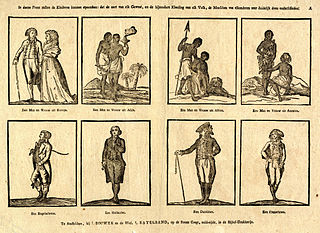In the psychology of self, one's self-concept is a collection of beliefs about oneself. Generally, self-concept embodies the answer to the question "Who am I?".
Sex differences in psychology are differences in the mental functions and behaviors of the sexes and are due to a complex interplay of biological, developmental, and cultural factors. Differences have been found in a variety of fields such as mental health, cognitive abilities, personality, emotion, sexuality, and tendency towards aggression. Such variation may be innate, learned, or both. Modern research attempts to distinguish between these causes and to analyze any ethical concerns raised. Since behavior is a result of interactions between nature and nurture, researchers are interested in investigating how biology and environment interact to produce such differences, although this is often not possible.
Stereotype threat is a situational predicament in which people are or feel themselves to be at risk of conforming to stereotypes about their social group. It is theorized to be a contributing factor to long-standing racial and gender gaps in academic performance. Since its introduction into the academic literature, stereotype threat has become one of the most widely studied topics in the field of social psychology.
Diane F. Halpern is an American psychologist and former president of the American Psychological Association (APA). She is Dean of Social Science at the Minerva Schools at KGI and also the McElwee Family Professor of Psychology at Claremont McKenna College. She is also past-president of the Western Psychological Association, The Society for the Teaching of Psychology, and the Division of General Psychology.

Mental rotation is the ability to rotate mental representations of two-dimensional and three-dimensional objects as it is related to the visual representation of such rotation within the human mind. There is a relationship between areas of the brain associated with perception and mental rotation. There could also be a relationship between the cognitive rate of spatial processing, general intelligence and mental rotation.
Spatial visualization ability or visual-spatial ability is the ability to mentally manipulate 2-dimensional and 3-dimensional figures. It is typically measured with simple cognitive tests and is predictive of user performance with some kinds of user interfaces.
The empathising–systemising (E–S) theory is a theory on the psychological basis of autism and male–female neurological differences originally put forward by English clinical psychologist Simon Baron-Cohen. It classifies individuals based on abilities in empathic thinking (E) and systematic thinking (S). It measures skills using an Empathy Quotient (EQ) and Systemising Quotient (SQ) and attempts to explain the social and communication symptoms in autism spectrum disorders as deficits and delays in empathy combined with intact or superior systemising.

In social psychology, a stereotype is a generalized belief about a particular category of people. It is an expectation that people might have about every person of a particular group. The type of expectation can vary; it can be, for example, an expectation about the group's personality, preferences, appearance or ability. Stereotypes are sometimes overgeneralized, inaccurate, and resistant to new information, but can sometimes be accurate.
The sexual division of labour (SDL) is the delegation of different tasks between males and females. Among human foragers, males and females target different types of foods and share them with each other for a mutual or familial benefit. In some species, males and females eat slightly different foods, while in other species, males and females will routinely share food; but only in humans are these two attributes combined. The few remaining hunter-gatherer populations in the world serve as evolutionary models that can help explain the origin of the sexual division of labor. Many studies on the sexual division of labor have been conducted on hunter-gatherer populations, such as the Hadza, a hunter-gatherer population of Tanzania.

Delusions of Gender: How Our Minds, Society, and Neurosexism Create Difference is a 2010 book by Cordelia Fine, written to debunk the idea that men and women are hardwired with different interests. The author criticizes claimed evidence of the existence of innate biological differences between men and women's minds as being faulty and exaggerated, and while taking a position of agnosticism with respect to inherent differences relating to interest/skill in "understanding the world" versus "understanding people", reviews literature demonstrating how cultural and societal beliefs contribute to sex differences.
In social identity theory, an implicit bias or implicit stereotype, is the pre-reflective attribution of particular qualities by an individual to a member of some social out group.
Spatial cognition is the acquisition, organization, utilization, and revision of knowledge about spatial environments. It is most about how animals including humans behave within space and the knowledge they built around it, rather than space itself. These capabilities enable individuals to manage basic and high-level cognitive tasks in everyday life. Numerous disciplines work together to understand spatial cognition in different species, especially in humans. Thereby, spatial cognition studies also have helped to link cognitive psychology and neuroscience. Scientists in both fields work together to figure out what role spatial cognition plays in the brain as well as to determine the surrounding neurobiological infrastructure.
Sex differences in humans have been studied in a variety of fields. Sex determination occurs by the presence or absence of a Y in the 23rd pair of chromosomes in the human genome. Phenotypic sex refers to an individual's sex as determined by their internal and external genitalia and expression of secondary sex characteristics.
Gender roles are culturally influenced stereotypes which create expectations for appropriate behavior for males and females. An understanding of these roles is evident in children as young as age four. Children between 3 and 6 months can form distinctions between male and female faces. By ten months, infants can associate certain objects with females and males, like a hammer with males or scarf with females. Gender roles are influenced by the media, family, environment, and society. In addition to biological maturation, children develop within a set of gender-specific social and behavioral norms embedded in family structure, natural play patterns, close friendships, and the teeming social jungle of school life. The gender roles encountered in childhood play a large part in shaping an individual's self-concept and influence the way an individual forms relationships later on in life.
Although there are many physiological and psychological gender differences in humans, memory, in general, is fairly stable across the sexes. By studying the specific instances in which males and females demonstrate differences in memory, we are able to further understand the brain structures and functions associated with memory.
Sex differences in human intelligence have long been a topic of debate among researchers and scholars. Most psychologists now believe that there are no significant sex differences in general intelligence, although ability in particular types of intelligence does appear to vary slightly on average.
Sex differences in cognition are widely studied in the current scientific literature. Biological and genetic differences in combination with environment and culture have resulted in the cognitive differences among males and females. Among biological factors, hormones such as testosterone and estrogen may play some role mediating these differences. Among differences of diverse mental and cognitive abilities, the largest or most well known are those relating to spatial abilities, social cognition and verbal skills and abilities.

Gina Rippon is a British neurobiologist and feminist. She is a professor emeritus of cognitive neuroimaging at the Aston Brain Centre, Aston University, Birmingham. Rippon has also sat on the editorial board of the International Journal of Psychophysiology. In 2019, Rippon published her book, Gendered Brain: The New Neuroscience that Shatters the Myth of the Female Brain, which investigates the role of life experiences and biology in brain development.
Neurosexism is an alleged bias in the neuroscience of sex differences towards reinforcing harmful gender stereotypes. The term was coined by feminist scholar Cordelia Fine in a 2008 article and popularised by her 2010 book Delusions of Gender. The concept is now widely used by critics of the neuroscience of sex differences in neuroscience, neuroethics and philosophy.
An empathy gap, sometimes referred to as an empathy bias, is a breakdown or reduction in empathy where it might otherwise be expected to occur. Empathy gaps may occur due to a failure in the process of empathizing or as a consequence of stable personality characteristics, and may reflect either a lack of ability or motivation to empathize.



